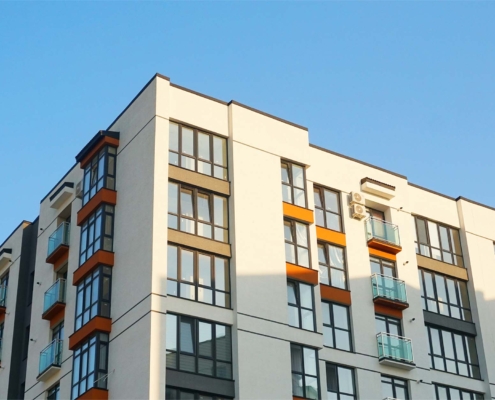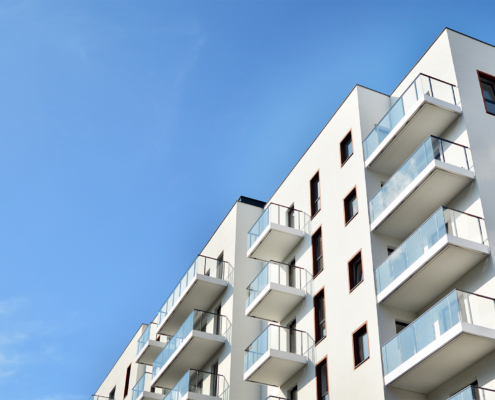 https://capitalconstructiongrp.com/wp-content/uploads/2025/08/multifamily-building-during-day.jpg
1250
2000
Abstrakt Marketing
/wp-content/uploads/2024/10/ccg_blue_transparent.png
Abstrakt Marketing2025-08-04 13:36:462025-10-10 13:23:49How to Refresh a Multifamily Exterior: 9 Helpful Tips
https://capitalconstructiongrp.com/wp-content/uploads/2025/08/multifamily-building-during-day.jpg
1250
2000
Abstrakt Marketing
/wp-content/uploads/2024/10/ccg_blue_transparent.png
Abstrakt Marketing2025-08-04 13:36:462025-10-10 13:23:49How to Refresh a Multifamily Exterior: 9 Helpful TipsComparing Multifamily Exterior Maintenance and Cosmetic Fixes
Keeping the exterior of a multifamily property in great shape involves more than just making it look nice. While a fresh coat of paint or modern siding color can turn heads, it’s the unseen maintenance work that truly protects your investment. From roofing and drainage to waterproofing and structural integrity, multifamily exterior maintenance is essential for tenant safety, risk reduction, and long-term property value.
Cosmetic upgrades absolutely play a role in attracting new tenants and retaining existing ones. But without a solid foundation underneath, literally and figuratively, those updates don’t last and could lead to much bigger problems. In this blog, we’ll walk you through the key differences between preventative building repairs and visual enhancements, explain how to budget for both, and give you the tools to make smarter, more cost-effective decisions for your property.
The Purpose of Exterior Maintenance
Multifamily exterior maintenance refers to the upkeep and repair of building systems and features that directly impact a property’s safety, durability, and performance. It’s the difference between stopping a small leak now or dealing with interior mold and tenant complaints later. This includes addressing aging infrastructure, routine inspections, and essential upgrades that prevent weather-related damage or deterioration over time. Exterior maintenance is an investment in asset protection and long-term savings.
Property Maintenance Checklist Items to Prioritize
Structural exterior components are often overlooked because they’re not glamorous, but neglecting them can have major consequences.
Roofing and Gutters
- Keep roofs inspected yearly for leaks, flashing damage, and soft spots.
- Clean and inspect gutters to prevent water from pooling near the foundation.
- Replace aging shingles or membranes before leaks cause drywall damage in units.
Waterproofing and Sealants
- Check exterior walls, balconies, and joints for failed caulking or cracks.
- Ensure window and door seals are intact to prevent interior water infiltration.
- Apply waterproof coatings to balconies, decks, or masonry surfaces exposed to weather.
Drainage Systems and Grading
- Evaluate site grading to ensure water flows away from buildings.
- Maintain French drains, storm drains, or trench systems to avoid flooding.
- Inspect and repair downspouts, especially in high-rainfall zones.
Structural Surfaces
- Address signs of movement or cracking in stucco, brick, or siding.
- Repair crumbling stair treads, railings, or walkways before they become hazards.
- Recoat decks or wood structures with weather-resistant sealers every few years.
These types of multifamily exterior maintenance tasks are essential for tenant safety and reducing legal and insurance exposure. They should be completed on schedule, even if no one notices them right away.
Cosmetic Renovations vs. Repair
Cosmetic fixes are mostly about visual improvements. They help your property appear modern, clean, and well-maintained, but they aren’t designed to solve structural problems.
Common Cosmetic Upgrades
- Repainting siding, trim, or front doors
- Updating the color scheme of the facade
- Replacing outdated light fixtures
- Installing decorative panels or modern railings
- Power washing walkways and buildings
- Adding new signage or branding elements
These upgrades can improve curb appeal quickly and contribute to a more desirable living environment. However, if done without addressing underlying maintenance needs, they can hide bigger issues or even be undone by water damage or structural movement.
The Risk of Delaying Structural Maintenance
Putting off critical exterior maintenance often leads to larger, more expensive repairs down the line. What starts as a clogged gutter or hairline crack can grow into a major issue requiring reconstruction, tenant relocation, or even legal consequences.
- Ignoring roof issues can result in water infiltration, mold, and ceiling collapse.
- Poor grading or drainage can cause foundation movement and cracks in living spaces.
- Deferred balcony or stair repairs can lead to safety hazards and liability claims.
Multifamily exterior maintenance protects your tenants and helps you avoid emergency costs that throw your budget into chaos.
Budgeting Considerations for Multifamily Structural Upgrades and Cosmetic Work
When planning upgrades, it’s essential to budget for maintenance first. Preventative investments may not offer the same visual transformation as a new paint job, but they protect every other dollar you spend.
Smart Budgeting Strategy
- Allocate 60–70% of your exterior renovation budget to structural and preventative work.
- Reserve 30–40% for cosmetic enhancements that align with marketing goals.
- Build an annual reserve fund specifically for roofing, waterproofing, and other critical systems.
- If planning a full refresh, complete maintenance work first to avoid redoing cosmetic finishes later.
This approach helps you maintain your property’s safety and marketability while keeping long-term costs under control.
Combining Visual and Functional Improvements
The good news is you don’t have to choose one or the other. In many cases, you can pair functional maintenance with cosmetic upgrades for maximum return.
- Replace damaged siding while upgrading color and trim style.
- Install new handrails that are safer and also modernize your stairwells.
- Refresh entryways with new lighting that improves both visibility and appearance.
- Repair concrete walkways and add decorative overlays for curb appeal.
These hybrid projects allow you to get ahead of safety issues while also giving your property a fresh, updated look.
At Capital Construction, we help property owners balance essential maintenance and smart cosmetic upgrades through well-planned, high-impact renovation projects. Learn more about how we can help.
Multifamily Exterior Maintenance and Cosmetic Prioritization Considerations
Use the following considerations to decide what needs attention now, and what can wait:
High Priority (Maintenance)
- Roof leaks or visible aging
- Soft or rotting exterior wood
- Poor drainage or grading issues
- Failing balconies, stairs, or railings
- Missing or broken seals on windows and doors
- Water damage to masonry or stucco
Medium Priority (Hybrid)
- Fading or stained paint on common areas
- Outdated lighting with visibility issues
- Cracked walkways or broken pavers
- Worn entry doors with poor insulation
- Stairwells with rusted treads or exposed hardware
Low Priority (Cosmetic)
- Color scheme updates
- Decorative panels or trim
- New signage or branding
- Outdoor furniture and fixtures
- Accent lighting or uplighting
This hierarchy helps you protect your investment while planning upgrades that also improve tenant satisfaction.
Why Exterior Maintenance Pays Off Long-Term
Staying ahead of multifamily exterior maintenance isn’t just about reducing emergencies. It helps extend the life of your building envelope, protect interiors from damage, and avoid the costly consequences of deferred upkeep. Properties with consistent exterior maintenance often see:
- Higher tenant retention rates
- Fewer insurance claims or liabilities
- Better reviews and reputation
- Increased property value and appraisal accuracy
- Longer lifespan of exterior components
Over time, these benefits lead to better NOI (Net Operating Income) and stronger long-term returns.
Secure and Enhance Your Property With the Experts at Capital Construction
Refreshing your building is exciting, but making sure it’s structurally sound is even more important. Multifamily exterior maintenance protects the integrity of your property, reduces risk, and saves money over time. When paired with thoughtful cosmetic upgrades, you create a safer, more appealing community that tenants are proud to call home.
Capital Construction offers exterior renovation and maintenance solutions that keep your property strong, attractive, and competitive in today’s rental market. Let’s build a plan that checks all the right boxes. Get in touch today.



